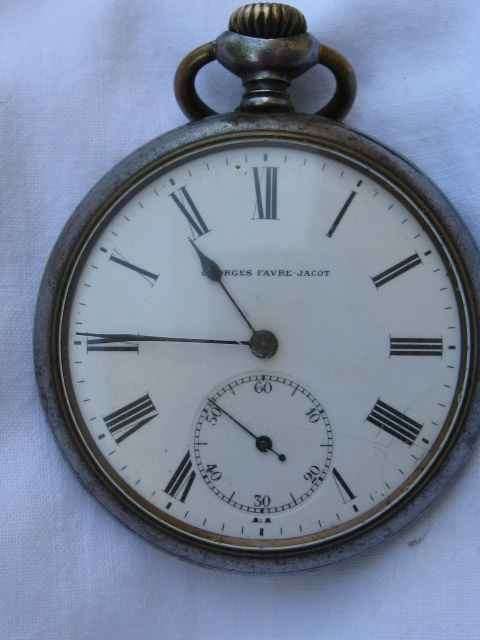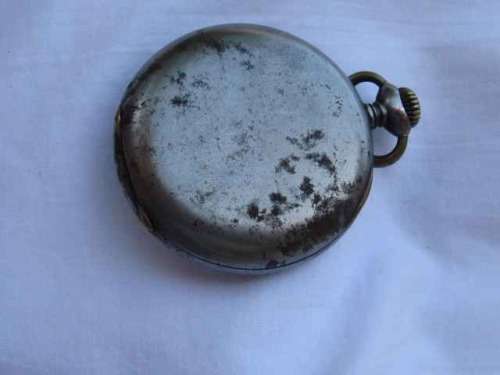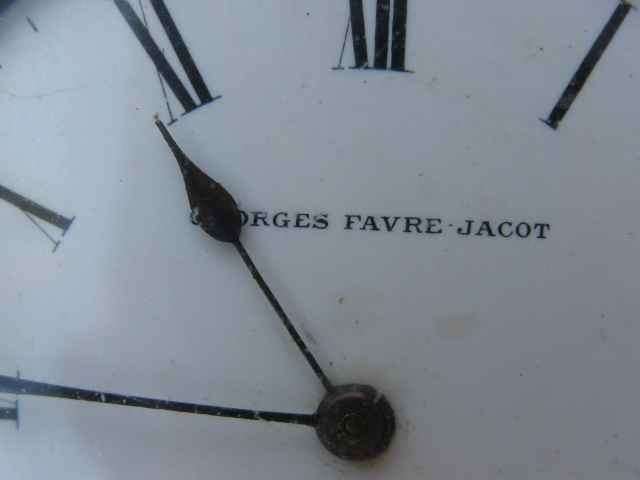
POCKET WATCH : GEORGES FAVRE JACOT : PAT.OCT.18 1904 : WORKING (not even 250 US dollars)
Check my rate
| Main centres: | 1-3 business days |
| Regional areas: | 3-4 business days |
| Remote areas: | 3-5 business days |

| Main centres: | 1-3 business days |
| Regional areas: | 3-4 business days |
| Remote areas: | 3-5 business days |
not serviced
. 18, 1904 G. FAVRB-JAGOT.
STEM WINDING AN D SETTING MEGHANISM FOR WATCHES.
APPLICATION FILED JUNE 21, 1904.
NO MQDE'L.
PATENT OEEIcE.
STEM WINDING AND SETTING MECHANISM FOR WATCHES- SPECIFICATION dated October 18, 1904.
To whom, it may concern:
Be it known that I, GEORGES FAvRE-JAco'r, watchmaker, a citizen of the Republic of Switzerland, and a resident of Le Locle, Switzerland, have invented a new Winding and Setting Mechanism, of which the following is a specification.
The mechanism which forms the object of the invention belongs to the kind known as negativethat is to say, mechanism in which the raising of the sliding pinion employed in the winding operation is effected by pushing in the crown-stem, while the lowering of this pinion for thepurpose of setting the watch is efiected by pulling the crownstem outward. One formof such mechanism is illustrated, by way of example, in the accompanying drawings. 7
Figure 1 is a plan, and Fig. 2 a section through A B in Fig. 1.
On the upper part of the winding-stem a a sliding sleeve 6 is loosely fitted, into the interior (Z of which the lower end of the crown or false stem 6 fits squarely. The windingpinion f, which is loosely mounted on the stem at, revolves in an opening g in the plate, a steel plate it being interposed between the upper part of the opening and thepinion f, so as to prevent the metal of the plate from being worn away by the teeth of the pinion.
The sliding pinion e', which can move freely along the lower part of the stem (6., is furnished with ratchet-teeth 7a, which engage with corresponding teeth on the pinion f.
Two arms Z and m pivot around a stud n, with a head 0 loosely fitted into a slot 39 in the plate, the stud being able to move freely in the direction perpendicular to the axis of the winding-stem. The free end of the arm Z engages with a neck 0, formed in sleeve 6, while the free end of the arm m engages in a neck 9 on the sliding pinion Z.
A spring 9, placed between a screw .9, fixed on the plate, and the part 6 of the arm m, tends constantly to push the pin a toward the rod 64,
whereby the two ends of the arms Z and m are pressed apart, and consequently the slidesleeve 6 held in its extreme raised position and the sliding pinion Z in its lowered position-that is, in engagement with the intermediate minute-wheel work for setting the watch. This position of the parts is indicated in the drawings by dotted lines.
By pressing on the stem 6 the slide-sleeve Z) is lowered and actuates the arm Z, which causes the stud n to move away from the stem 64 and raises the arm m, which puts the teeth Z; of the sliding pinion t' int'oengagement with the winding-pinion f. .This position is shown in fully-drawn lines in Fig. 1. In this position the spring r-in acting on the flattened part t of the arm at keeps the teeth belonging, respectively, to the parts a and f in engagement. Thus the spring r has a double action.
The stud'n and the larger part of the arms Z on, as well as the spring 7, are covered by a plate 0, which is only shown in dotted lines in Fig. 1. The slide-sleeve Z) may be fixed to the stem a. In such case a portion of the lower part of this stem is made cylindrical, so as to allow the stem the required longitudinal play.
Having now described my invention, I claim as new and wish to secure by Letters Patent A winding and setting mechanism comprising a winding-stem, a sliding sleeve on said stem, a winding-wheel freely rotatable on the stem, below said sleeve, a sliding pinion rotating with said stem below the wheel, a stud having sliding movement perpendicularly to the axis of the winding-stem, arms pivoted at one end to said stud and engagingone with the sleeve and the other with thepinion so as to move the same longitudinally when the stud is moved, and a spring for controlling said stud.
In witness whereof I have hereunto set my hand in presence of two witnesses.
GEORGES FAVRE-JACOT. Witnesses: 1
J ULES OHAPUY, VITAL SCHUROH.
Hill
.JPG)
0256_(640x480).JPG)
.JPG)
.JPG)
.JPG)
0250_(640x480).JPG)
0246_(640x480).JPG)
0246_(640x480).JPG)
0242_(640x480).JPG)


